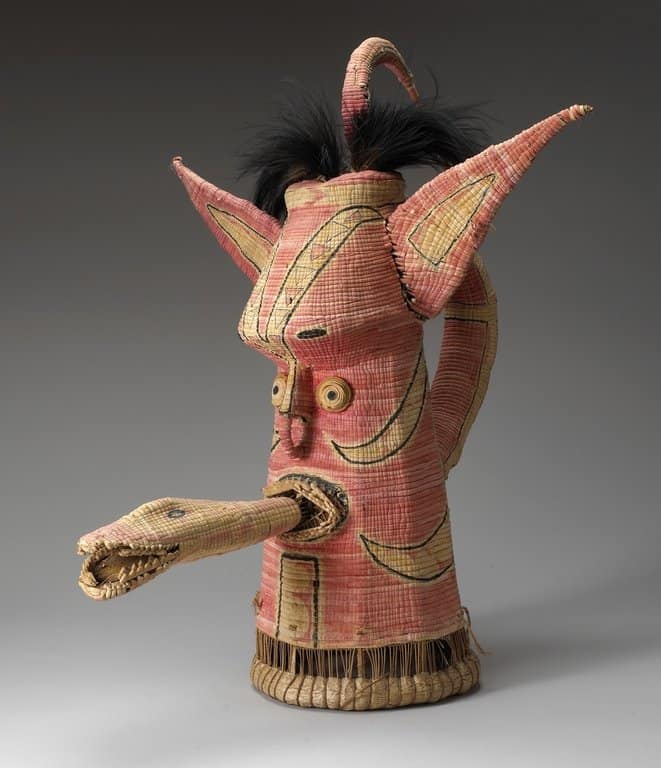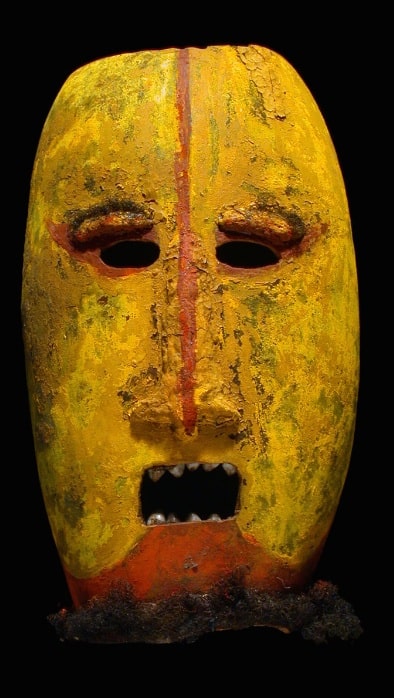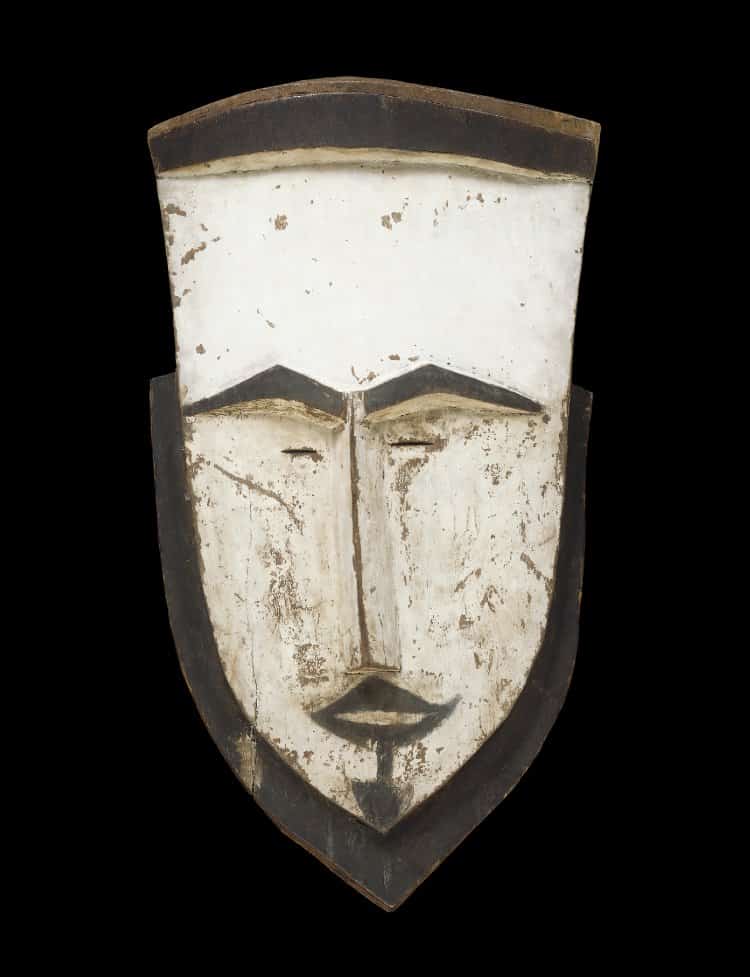Pacific Island Masks
Pacific Island Masks come in various types. Types vary mainly depending on the region/tribe they come from. This article is to help the reader identify where in the Pacific their Pacific Island mask is from by giving examples and pictures of the different types.
The best known Papua New Guinea mask come from the Sepik River which is in a separate article.
I Buy old Pacific Island masks and old tribal Art. If you have one to sell or if you want to know how much a mask is worth, please contact me. I would love to see it.
Don’t know where your mask is from. Send me a Jpeg I can help.
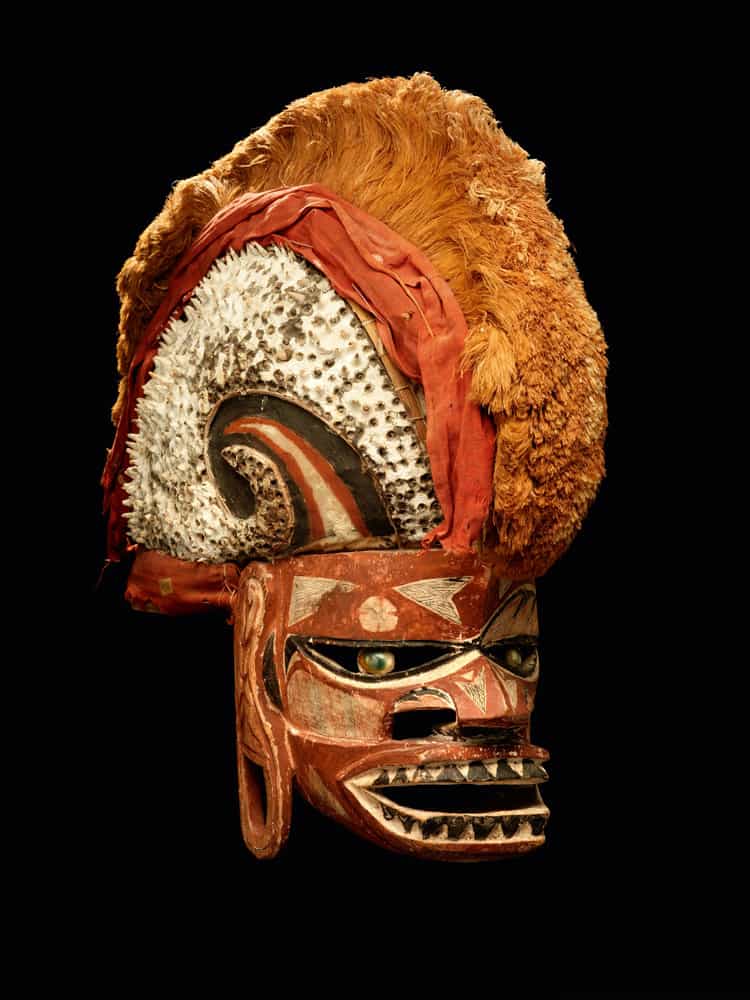

Pacific Island Masks general information
Many Pacific Island Masks are to empower objects. They were to empower sacred flutes canoes, the HausMan, as lucky amulets and even yams. Other Pacific Island masks were not made to wear directly on the head but were part of a larger assemblage. Masks that people wear are normally referred to as dance masks.
Many masks are wooden but there are others made from tree bark over a rattan frame. Not all areas of Papua New Guinea made masks
Types of Pacific Island masks vary from very small Amulet masks only a few centimeters, to huge Baining masks over 10 meters tall.
In Papua New Guinea it is only men who wear or make masks and they must be an initiate in that cult. Masks are not used by women. It is Tabboo for women to see or touch masks other than during a ceremony.
Masks are the spirits and ancestral deities. When worn the initiate becomes the spirit / tumbuwan the mask represents. Masks are still used today in New Guinea and dance during ceremonial occasions.
The following is a visual guide on types of Pacific Island Masks but due to the huge variety throughout the country is not inclusive. It is better to think of this a brief introduction to this fascinating group of oceanic art forms.
If you have an old Tribal mask you think is from New Guinea, feel free to send me some images.
Pacific Island Masks by Area
Micronesiam Masks / Mortlock Island masks
Masks are rare in Micronesia – traditionally they are only found in the Mortlock group of islands (Caroline Islands). Called Tapuanu they are breadfruit wood painted white using lime and black using Charcoal. The mask has narrow eye-slits and a plaited coconut fiber cord for securing it to the wearer’s head.
These masks represented an ancestor ana. Used in ceremonial dances to protect the staple breadfruit crop from damaging storms. The ceremony took place in March or April, and included dancing and feasting.
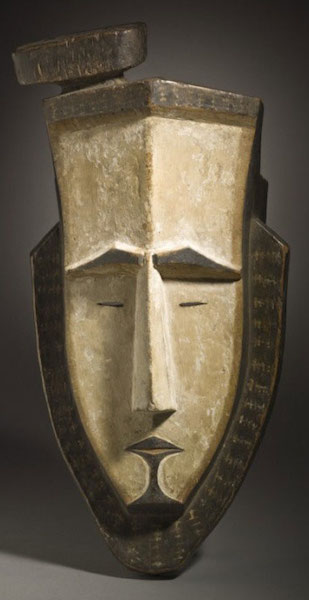

New Caledonian Kanak Masks
Mourning Masks from New Caledonia represent a dead chief. It is adorned with hair, probably from the men mourning the chief’s death. In the north of New Caledonia, mourners wore masks such as these during his mortuary ceremony. The performer wore the mask high. looking out from the mask’s mouth, rather than the eyes. The masked dancer would hit out at the assembled people with clubs. The symbolism of the mask made connections with the underwater world of the dead and its acting performance was supposed to underline the chief’s abiding power.
These masks are very collectable especially those with exaggerated noses,


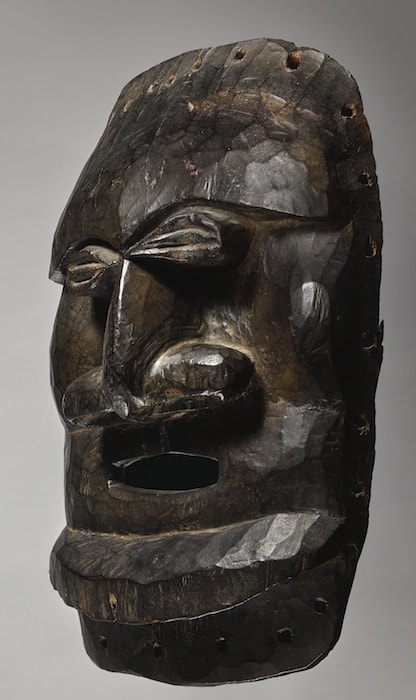


Papuan Gulf Masks
Papuan Gulf masks made from tapa cloth over a cane frame come from the region between Kerema and Orokolo. They were for a complex dance cycle.
Other Papuan Gulf masks made from woven cane come from West of Orokolo through to Kikori.
Tapa masks are in general more collectible. They tend to be brighter and more dynamic.


Baining Mask
Baining masks are some of the Largest masks in the world and made from tapa over a rattan frame. They usually have extremely large distinctive circular eyes.
Despite their size, they are not that uncommon. Many cruiseliners stopped in Rabaul in the 1970’s and watched the Baining fire dance. After the performance, these masks were sold to the cruise passengers.


Polynesian Masks
The New Zealand Maori were the only Polynesians to make masks.
Maori masks were not made to wear but were usually on ceremonial house gables. Masks were to spiritually empower important buildings.
They are discussed more in my article on Maori art. Maori masks are rare and authentic examples extremely collectible.

Sulka Masks
Masks from the Sulka or Suluka people in East new Britain made of pith finely sewn onto a cane frame. They are a distinctive pink color. The masks come in two main sizes. Large masks have an elaborate umbrella type structure on the top. These masks are rare and highly collectible.
Masks from Pomio are similar to Sulka but less flamboyant.

Malangan Pacific Island Masks
Malangan tribal masks come from the Northern Part of New Ireland and carved from a lightwood. Normally they are very intricate and show very high degrees of workmanship.
Traditionally they were burnt or left to rot after a Malangan Ceremony.
There is a huge variety in different styles of malangan mask. Often they are made from a variety of different materials






Tribal Masks Huon Gulf
Huon Gulf tribal masks come in two main types. The ones made from wood Have very distinctive ears. They are always done with openwork to reflect the importance of ear piercing as part of initiation in this area. The eye slits are usually below the carved eyes.
Tapa masks are tapa over a cane infrastructure. Often the nose is made from a carved piece of wood.
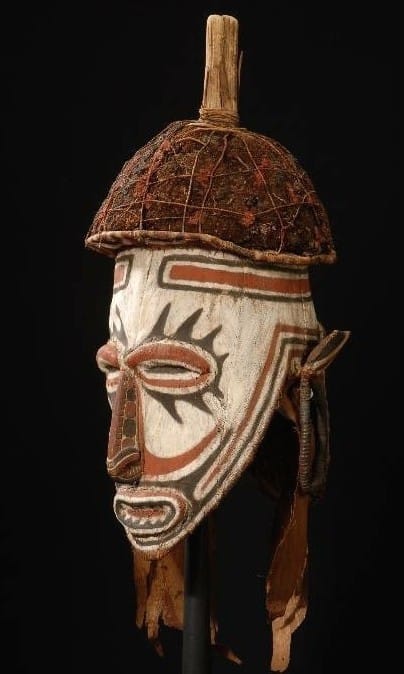


Lorr Masks
Lorr masks come from Southern New Ireland and East New Britain
The faceplates are wooden and the support structure cane. the hair is normally made of coconut fibre.
On older masks, it is quite often the wooden favce plate that survives
Astrolabe Bay masks
These masks are wooden and very rare. Stylistically similar to Huon Gulf wooden masks. Astrolabe bay was an early German settlement and mask ceased being made over 100 years ago.
They are the most sort after and collectible New Guinea mask.
Huon Gulf masks tend to have less variation in forms.

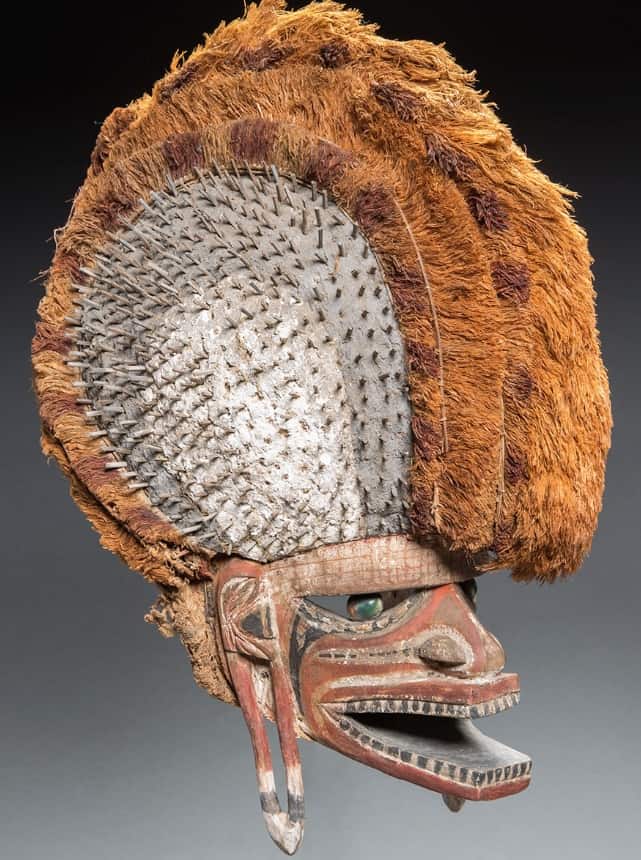
Tantanua Masks
Tantanua masks from New Ireland have an easily recognized mohawk hairstyle. They usually have a lightwood faceplate and fiber top.
They are often incorrectly referred to as malangan masks. Unlike Malangan masks, Tantanua are not destroyed after the ceremony.
They are one of the visually most dynamic masks from New Guinea and are very collectable.

Highlands Masks
The New Guinea highland, in general, have very few masks. The masks they do have though tend not to be made from wood. Instead, they use materials like cane gourd and pandanus leaves.
They also make a mask from half a gourd. These are used to get rid of leprosy and are often painted yellow and red.
The highlands are better known for their Brightly painted war shields and body adornments.

Tanga Mask
Tanga tribal Masks made of tapa over a cane structure. Although they tend to be coarsely made their forms are some of the wildest in all of Oceanic Art.

Nissan Island Mask
New Guinea Masks from Nissan island made from tapa over the top of a cane framework.
They are quite rare and can be considered culturally as Solomon island Art
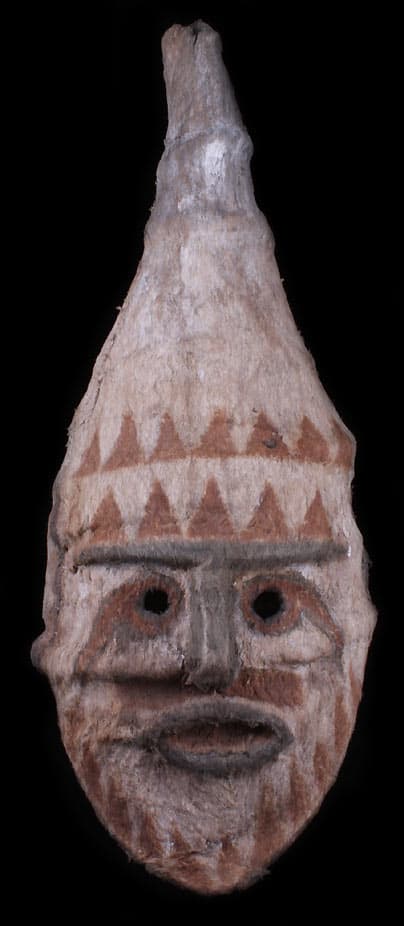

Sepik Masks
Masks from the Sepik / Ramu Region in Papua New Guinea just about outnumber masks from all other Regions.
They deserve an article for themselves. please feel free to read my article Sepik masks.
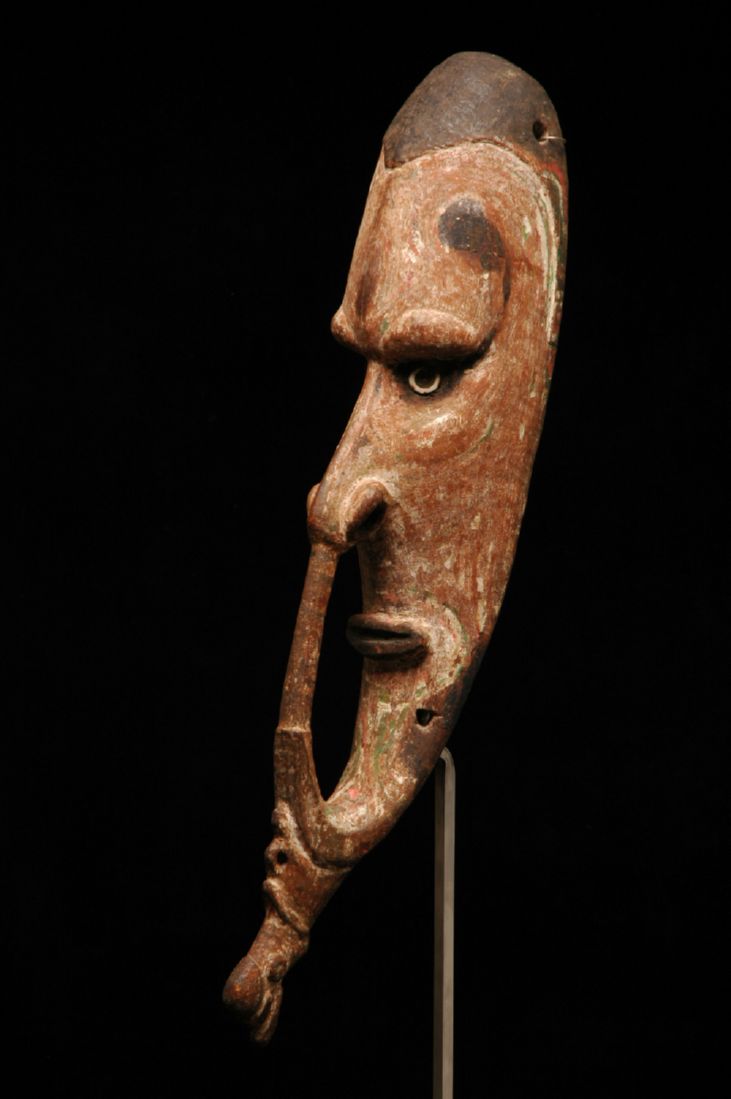
Pacific Island Masks
I hope you can appreciate the vast variety of Pacific Island masks. The South Pacific is one of the most prolific mask-producing regions of the World. As Art, they are extremely expressive and come in a vast variety of sizes forms and functions.
If you enjoyed this article I have other articles on New G
All images in this article are for educational purposes only.
This site may contain copyrighted material the use of which was not specified by the copyright owner.




